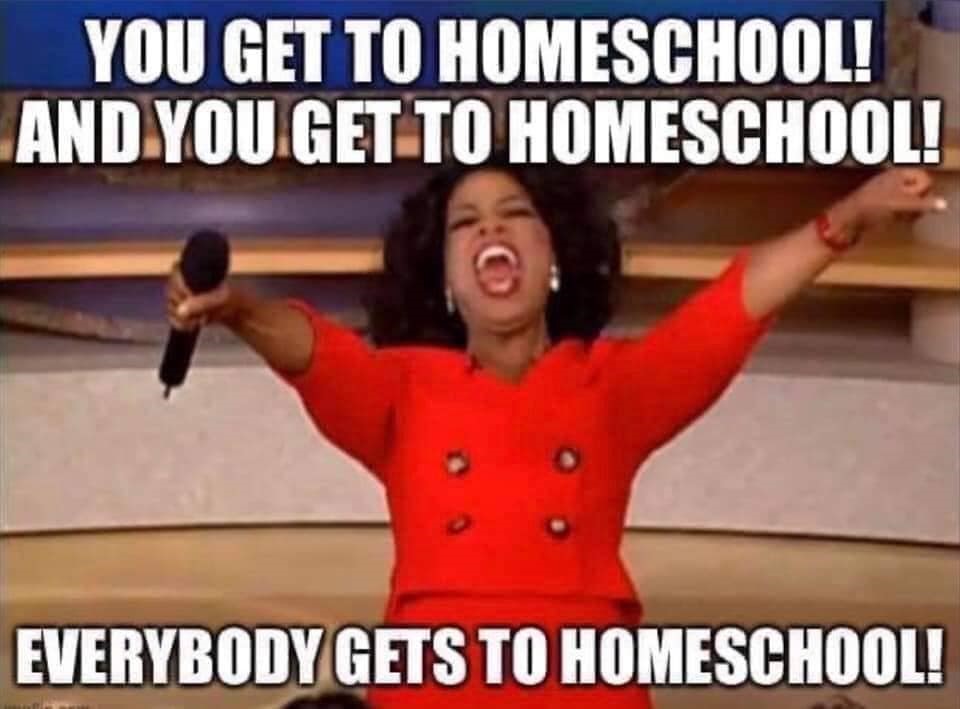Let me give you a few simple ideas, informed by
decades of homeschool experience, that will help you and your kids make the
most of your weeks at home together.
As schools across America close to slow the spread of the COVID-19
virus, those of us in the homeschool community—perennial outsiders that we
are—are a little giddy over our sudden mainstream status.


As amusing as these memes are (and believe me, homeschoolers find
them amusing), there’s just one problem: they’re not exactly true.
Yes, if you have school-age children who are spending the next few
weeks at home, in many ways your life is going to look a lot more like ours.
But let me acknowledge something from the outset: your task isn’t exactly the
same as homeschooling.
You didn’t get to plan ahead and structure your life for this; we
did. Your school year has been significantly disrupted; ours hasn’t. Perhaps
most significantly, and contrary to myth, “social distancing” isn’t the norm
for homeschoolers. We have co-ops, clubs, and events that have been cancelled
for coronavirus too. The next few weeks are going to be hard on all of us.
So, given the unique features of this crisis, I’m not here to give
my typical “how to homeschool” advice. As you adjust to this sudden lifestyle
change, the last thing you need to do is research your state’s homeschool laws,
set big-picture educational goals, or choose a comprehensive curriculum, which
most homeschoolers would have months to consider and a full school year to
execute.
Instead, let me give you a few simple ideas—informed by decades of
homeschool experience—that will help you and your kids make the most of your
weeks at home together.
1. Don’t Think You Have
to Fill Your Day with Academics
One of the first things I tell new homeschoolers often surprises
them: for young children, homeschooling doesn’t take much time. When my kids
were in kindergarten through third grade, their academic day usually didn’t
last longer than two hours. When instruction is individualized and interstitial
classroom time eliminated, it’s very easy to give your students all the book
learning they need before lunch time. (Older students will take more time, but
their day is still comparatively streamlined.)
So unless
your child’s school has assigned an obscene amount of mandatory homework, don’t
plan to work on academics for the same length of time as he or she typically
spends in school. Embrace the freedom of sleeping in and having more time
for learning through play.
2. Make the World Your
Classroom
The real “secret sauce” of homeschooling, especially for younger
children, isn’t so much a method as a mindset. Homeschoolers don’t look at
education as something that happens within the bounds of a book or a building.
Our approach is to integrate learning with life, looking for educational
opportunities in everyday outings and experiences.
This can be as simple as putting up a bird feeder outside your
kitchen window and helping your kids identify birds, or going on nature walks and
observing different types of trees as they bloom. Since it’s springtime in
North America, this is a great opportunity to get outside together and enjoy
the natural world.
If you have an available spot for a small outdoor garden, or even
a sunny windowsill, your kids could learn about botany by growing some seeds.
Although access to museums may be limited due to COVID-19, many historical
buildings or battlefields lend themselves to an open-air ramble or driving
tour.
Be creative, have fun, and remember that your goal isn’t
encyclopedic knowledge or complete mastery of the subject matter. You’re trying
to spark your children’s imagination and curiosity so the subject comes alive,
and learning becomes a lifestyle.
3. Read, Read, Read
One of the most valuable things I’ve done in 13 years of
homeschooling is to read aloud with my children every day, even when they got
older. For us, this works best first thing in morning, but feel free to
experiment and find the time that works best for your family.
If you and your kids are new to reading aloud, I’d suggest
fighting the urge to be too ambitious with an overly difficult book. Choose
something you read and cherished as a child, a favorite book that captured your
imagination. (This has added relationship value, as you share a treasured
memory with your children.) Once you establish the rhythms of reading together,
you can challenge them with more difficult books than they would otherwise be
able to read independently.
The academic and relationship
benefits of reading together are innumerable. All of my
children are natural writers today, and I credit much of that to our daily
habit of reading aloud.
4. Use This Time to
Teach Life Skills
For older children, this sudden school closure strikes me as the
perfect time to impart life skills they won’t learn in school. Children in
upper elementary grades and older can learn how to cook a meal, do a load of
laundry, wash the dishes, and clean a bathroom. Middle schoolers and high
schoolers can learn the basics of planning meals, writing grocery lists,
household budgeting, mowing the lawn, and changing a flat tire.
Beyond household management, parents can draw on their hobbies and
work skills and teach sewing, carpentry, art, or computing. If you have a skill
that serves you in life that your child is able to learn, now is a great time
to teach it. Why spend these weeks duplicating classroom academics when you can
give them something useful and completely new?
5. Channel Your Inner
‘80s Parent
This season of “social distancing” gives all of us a chance to let
our kids experience the gift of unstructured time. Modern parents are so prone
to overscheduling our kids’ lives that the sudden cancellation of activities
and events feels jarring. Yet it’s a rare opportunity—maybe the only one we’ll
get in our lifetimes—to have a few weeks at home without much to do.
Think of it
as a trip in a time machine back to your childhood. Remember the things you
used to do to amuse yourself during the long, pre-internet summer days. Send
your kids outside to play, and tell them not to come in until dinner. Show them
how to make daisy chains, let them dig in the mud, and let them toss a ball
around. Let them get bored. It’s good for them!
Then, once the dust has settled and the health crisis is past,
consider homeschooling for real. You may have realized that the flexibility,
creativity, and customizability of home education is just right for your
family—and that it protects your kids from dangers beyond just a virus. Or
maybe you’ll weep with joy upon the return of the school bus. Either way, these
weeks will have been well spent.
Jayme
Metzgar is a Senior Contributor at The Federalist.